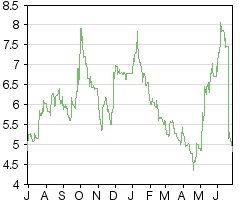QGC001 Phase IIa results at long last
In June 2017, Quantum Genomics reported the results from the Phase IIa pilot study of QGC001 for the treatment of patients with mild to moderate essential hypertension. QGC001 is a brain aminopeptidase A inhibitor (BAPAI), a novel class of potential anti-hypertensives targeting the brain renin-angiotensin pathway. The study was previously completed in mid-2016, however the results were released as part of a presentation of the study’s lead investigator at the 27th annual European Meeting on Hypertension and Cardiovascular Protection.
The trial was a randomised, double-blind, crossover study that measured the change in systolic blood pressure (SBP) in 34 patients over four weeks. Patients were dosed with 250mg of QGC001 twice a day for a one-week lead-in period, followed by 500mg per day. The primary outcome of the study was the reduction in ambulatory SBP measured over daytime hours using a blood pressure monitor. Patients showed a 2.7 mmHg improvement in this measure when compared to placebo, although the difference fell short of statistical significance (p=0.16). The patient’s supine in-office blood pressure, measured by a clinician, improved more compared to placebo at 4.7 mmHg, although this measure also failed to reach significance (p=0.15). Other blood pressure measurements, including diastolic blood pressure (DBP) were generally insignificant (Exhibit 1).
Exhibit 1: Effect of QGC001 on different blood pressure measurements.
Measurement |
Period |
Placebo adjusted change (mmHg) |
SBP |
p |
DBP |
p |
Ambulatory |
Daytime |
-2.70 |
0.16 |
-1.80 |
0.24 |
|
Night-time |
-0.51 |
0.85 |
0.64 |
0.67 |
|
24h |
-2.00 |
0.31 |
-1.04 |
0.48 |
Office |
|
-4.65 |
0.15 |
-0.71 |
0.75 |
The study was small for a blood pressure study at only 34 patients (which can often reach into the thousands). It is therefore unfortunate, but not necessarily surprising, that statistical significance was missed. Also, approved blood pressure medications typically show an improvement in SBP (after placebo adjustment) from 9-14 mmHg. This effect size is seen across a range of classes treating patients with similar baseline SBP (Exhibit 2). We should note that there is potential for the treatment effect to increase with increased treatment duration, and this effect has been shown for instance with Diovan (valsartan).
Exhibit 2: Improvement in SBP from a selection of drugs*
Drug |
Class |
Measurement |
Duration |
Baseline SBP (mmHg) |
Reduction in SBP, placebo adjusted** (mmHg) |
QGC001 |
BAPAI |
Daytime ambulatory |
4 weeks |
150 |
2.7 |
QGC001 |
BAPAI |
Supine |
4 weeks |
148 |
4.7 |
Vasotec (enalapril) |
ACE inhibitor |
Seated |
4 weeks |
147 |
14 |
Norvasc (amlodipine) |
Calcium channel blocker |
Standing |
24 hours |
N/R |
12 |
Diovan (valsartan) |
ARB |
Supine or Seated |
8 weeks |
151 |
9 |
Tekturna (aliskiren) |
Renin inhibitor |
Seated |
8 weeks |
151 |
12 |
Source: Quantum Genomics, FDA labels, FDA review documents. Note: *For illustrative purposes using historical data and not head-to-head comparisons. **Maximum effective dose reported. BAPAI = brain aminopeptidase A inhibitor. ARB = angiotensin receptor blocker. ACE = angiotensin converting enzyme. N/R = not reported in available documents.
Quantum Genomics did a multi-variate analysis that gives some insight into the variables contributing to drug response. The variable with the highest significance was the patient’s baseline daytime SBP prior to entering treatment (p=0.01), because patients with the highest blood pressure when entering the study had the highest response. This is consistent with previous data in rats and humans that suggests that the response correlates with disease severity. In previous studies, the drug had no effect on subjects with normal blood pressure.
The second most significant variable was the difference between patients during treatment and while on placebo at p=0.06, which is much better than in the more naive primary analysis. This suggests that other confounding imbalances between patients worsened the significance of the primary outcome. These issues can at least in part be addressed through future trial design, in particular a larger patient sample size enabling better randomisation.
The adverse event profile was similar between QGC001 and placebo and largely benign (Exhibit 3). Two patients discontinued from the trial due to adverse events, and one withdrew (during the placebo portion) due to severe hypertension. Importantly, the company also did bloodwork on participants and demonstrated that the treatment did not affect any hormones implicated in hypertension (such as renin or aldosterone, among others), suggesting that the drug’s effect is the on-target action on BAPA.
Exhibit 3: QGC001 adverse events
|

|
|
|
The next clinical step for the company is to initiate its planned Phase IIb hypertension study in the US, which is slated to begin in autumn 2017. The trial will build on the findings of this study and include 250 patients with so-called “complicated hypertension,” or those with increased cardiovascular risk. There is potential for the company to enrich the study population for patients with low renin forms of hypertension. These patients are typically unresponsive to angiotensin receptor blockers (ARBs) and angiotensin converting enzyme (ACE) inhibitors, but are expected to respond to BAPAIs like QGC001. The company was previously unable to selectively enrol patients with this disease subtype due to restrictions on racial bias in clinical studies in France. Approximately 25% of hypertensive Americans have a low renin form, and up to 52% of the African American community. The company has stated that it will release the full details of the trial design on 27 June 2017. We currently forecast the trial costing between €5m and €6m, although we may adjust this based on these details. The company is also currently enrolling a European Phase IIa heart failure study, with a primary completion date around the end of 2017 and data expected in H118.


















